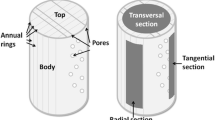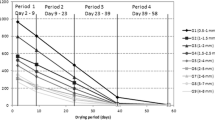Abstract
The aim of this study was to evaluate the potential of near infrared spectroscopy (NIRS) in predicting the coefficient of porosity of raw and boiled cork samples used mainly for producing cork stoppers for wine bottling. The classification of cork planks is currently performed visually in the last stage of preprocessing after boiling in water. In this study, calibration models have been developed on 279 cork samples before and after boiling. Three models were obtained: one which predicts the coefficient of porosity of unprocessed samples, a second one that predicts porosity in boiled samples and finally a model that predicts the coefficient of porosity of boiled samples from spectra of raw samples. The models obtained showed a coefficient of determination of 0.58, 0.59 and 0.52, respectively. These results show that the modified partial least squares models based on NIRS technology can be used for screening cork porosity, not only at the two stages of processing, but also to predict boiled porosity. This suggests that NIRS technology could be used for determining the coefficient of porosity in boiled cork planks, and could also provide a useful tree selection tool.




Similar content being viewed by others
References
AACC (1999) Near-Infrared methods: guidelines for model development and maintenance—AACC method 39-00. Approved Methods of the American Association of Cereal Chemists. AACC Press, St. Paul
Barnes RJ, Dhanoa MS, Lister SJ (1989) Standard normal variate transformation and de-trending of near-infrared diffuse reflectance spectra. Appl Spectrosc 43:772–777
Beja N (2001) Influência da qualidade das pranchas de cortiça no rendimento e no perfil de qualidade de rolhas de cortiça natural. The influence of cork planks quality on the performance and the quality of natural cork stoppers. (In Portuguese) MSc dissertation. Technical University of Lisbon
Burns DA, Ciurczak EW (1992) Handbook of near-infrared analysis, vol 13. Marcel Dekker Inc., New York
Conde E, Cadahía E, Garcia-Vallejo MC, Gonźalez-Adrados JR (1998) Chemical characterization of reproduction cork from Spanish Quercus suber. J Wood Chem Technol 18:447–469
Cumbre F, Lopes F, Pereira H (2000) The effect of water boiling on annual ring width and porosity of cork. Wood Fiber Sci 32:125–133
Fortes MA, Rosa ME, Pereira H (2004) A Cortiça (Cork). IST Press, Lisboa (In Portuguese)
Gómez-Sánchez I, García de Ceca JL, García-Olmo J, Lara-Buil L, López-Luque R, Prades C (2013) Application of image analysis and NIRS technology to the evaluation of the posority of planks, sheets and cork stoppers, and its relation with the industrial quality (in Spanish). Maderas Cienc Tecnol 15:293–309
Gonzalez-Adrados JR, Lopes F, Pereira H (2000) Quality grading of cork planks with classification models based on defect characterisation. Holz Roh-Werkst 58:39–45
González-Adrados JR, García de Ceca JL, González-Hernández F (2005) Anomalies assement and cork quality grading. In: Zapata S (ed) International congress Cork oak woodlands and cork industry: present, past and future. Palafrugell cork oak museum, Palafrugell, pp 276–291
Lawton JR (1980) bservations on the structure of epidermal-cells, particularly the cork and silica cells, from the flowering stem internode of Lolium-temulentum L (Gramineae). Bot J Linn Soc 80:161–177
Pereira H (1981) Studies on the chemical composition of virgin and reproduction cork of Quercus suber L. An Inst Super Agron 40:17–25
Pereira H (2007) Cork: biology, production and uses. Elsevier, Amsterdan
Pereira H, Tome M (2004) Non-wood products: Cork oak. In: Burley J, Evans J, Youngquist J (eds) Encyclopedia of forest sciences. Elsevier, Amsterdan, pp 613–620
Pereira H, Melo B, Pinto R (1994) Yield and quality in the production of cork stoppers. Eur J Wood Prod 52:211–214
Pereira H, Lopes F, Graça J (1996) The evaluation of the quality of cork planks by image analysis. Holzforschung 50:111–115
Prades C, García-Olmo J, Romero-Prieto T, Ceca JLGD, López-Luque R (2010) Methodology for cork plank characterization (Quercus suber L.) by near-infrared spectroscopy and image analysis. Meas Sci Technol 21:065602d
Prades C, Gomez-Sanchez I, Garcia-Olmo J, Ramon Gonzalez-Adrados J (2012) Discriminant analysis of geographical origin of cork planks and stoppers by near infrared spectroscopy. J Wood Chem Technol 32:54–70
Prades C, Gómez-Sánchez I, García-Olmo J, González-Hernández F, González-Adrados JR (2014) Application of VIS/NIR spectroscopy for estimating chemical, physical and mechanical properties of cork stoppers. Wood Sci Technol 48:830–844
Rosa ME, Pereira H, Fortes MA (1990) Effects in the production of cork stoppers of hot water treatment on the structure and compressive properties of cork. Wood Fiber Sci 22:149–164
Sánchez-González M, Del Rio M, Cañellas I, Montero G (2006) Distance independent tree diamter growth model for cork oak stands. For Ecol Manag 225:262–270
Sánchez-González M, Cañellas I, Montero G (2008) Base-age invariant cork growth model for Spanish cork oak forests Eur. J For Res 127:173–182
Schimleck LR, Doran JC, Rimbawanto A (2003) Near infrared spectroscopy for cost-effective screening of foliar oil characteristics in a Melaleuca cajuputi breeding population. J Agric Food Chem 51:2433–2437
Shenk JS, Westerhaus MO (1995) Routine operation, calibration, development and network system management manual. Silver Spring, Maryland
Shenk JS, Workman JJ, Westerhaus MO (1992) Application of NIR spectroscopy to agricultural products. In: Burns DA, Ciurczak EW (eds) Handbook of near-infrared analysis. Marcel Dekker Inc., New York
Starr C, Morgan AG, Smith DB (1981) An evaluation of near-infrared reflectance analysis in some plantbreeding programs. J Agric Sci 97:107–118
Williams PC, Sobering DC (1993) Comparison of commercial near infrared transmittance and reflectance instruments for analysis of whole grains and seeds. J Near Infrared Spectrosc 1:25–33
Williams P, Sobering D (1996) How do we it: brief summary of the methods we use in developing near infrared calibration. In: Davis AMC, Williams P (eds) Near infrared spectroscopy: the future waves. NIR Publications, Chichester, pp 185–188
Acknowledgments
This research work has been made possible through the collaboration agreement CC13-045 between INIA-CIFOR and the University of Córdoba in order to carry out joint research activities related to cork quality and cork stopper performance. The NIR data were obtained using NIRS hardware and software by the NIR/MIR Spectroscopy unit of the SCAI at the University of Cordoba. The authors would like to thank the INIA-CIFOR Cork Laboratory assistants Maria Luisa Cáceres, Esteban and Lorenzo Ortiz Buiza for all their work in the laboratory, Florentino González Hernández for his collaboration on this work and Juan Carlos Sánchez González for taking the spectra.
Author information
Authors and Affiliations
Corresponding author
Rights and permissions
About this article
Cite this article
Sánchez-González, M., García-Olmo, J. & Prades, C. Correlation between porosity of cork planks before and after boiling using near infrared spectroscopy. Eur. J. Wood Prod. 74, 509–517 (2016). https://doi.org/10.1007/s00107-016-1014-5
Received:
Published:
Issue Date:
DOI: https://doi.org/10.1007/s00107-016-1014-5




